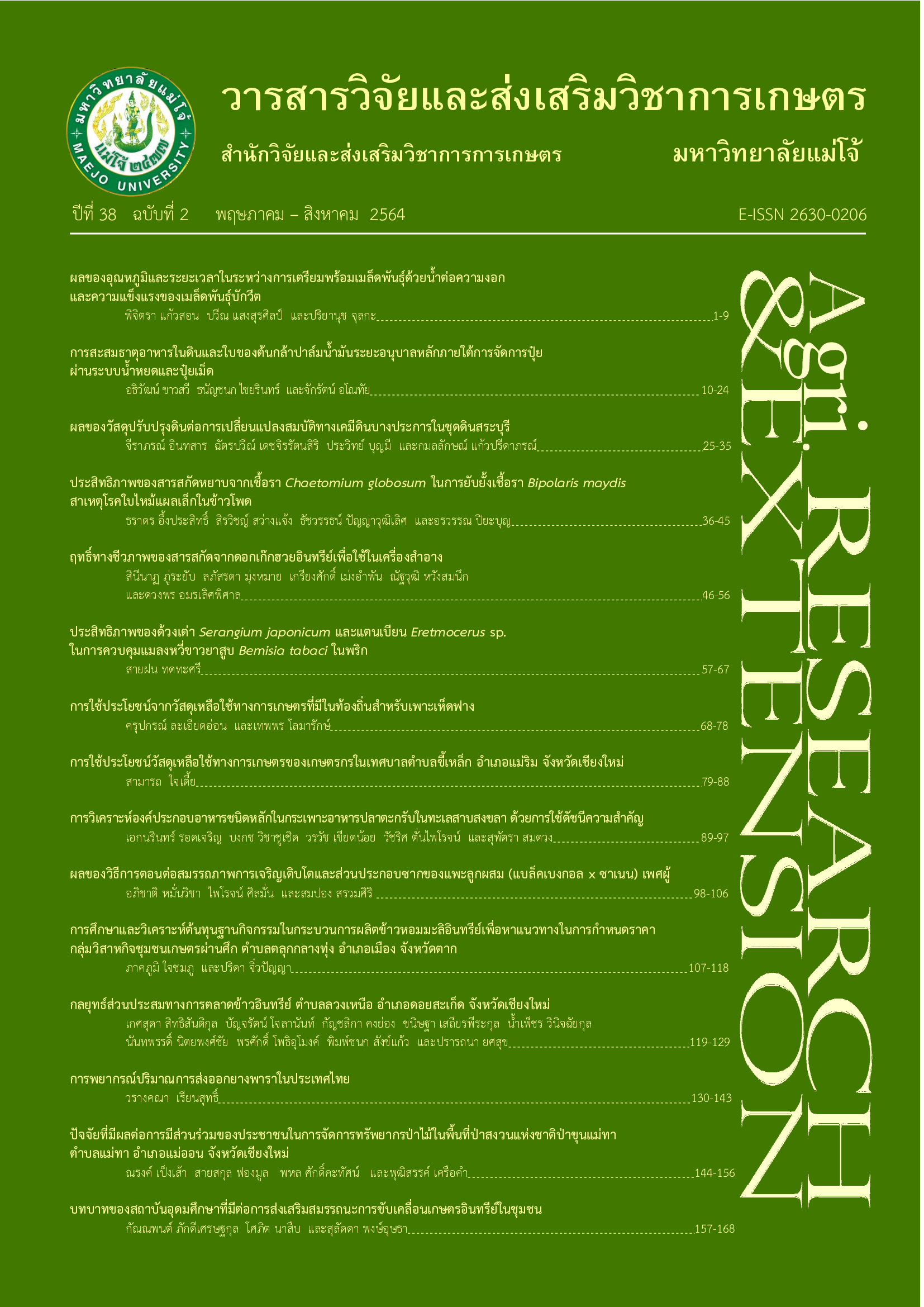Efficiency of Crude Extracts from Chaetomium globosum to Inhibit Bipolaris maydis Caused of Maize Leaf Blight Disease in Corn
Keywords:
crude extracts, dual culture test, percent inhibition of radial growth, leaf blight diseaseAbstract
Bipolaris is a pathogenic fungus causes of maize leaf blight disease in corn which reduce the photosynthesis and production of corn in Thailand. The use of biological methods to control plant diseases, especially the use of Chaetomium globosum, has the potential to control various pathogenic fungi. This research was to study the efficiency of C. globosum inhibitory activity against B. maydis and the crude extract of C. globosum inhibitory activity against B. maydis under laboratory and greenhouse conditions. The first method was tested the efficiency of crude extract from C. globosum for inhibiting B. maydis under laboratory condition using dual culture test. The result showed that inhibition percentage of radial growth was 51.16%. In addition, fungal antagonist was extracted by solvent extraction method using methanol and ethyl acetate and tested for growth inhibition of B. maydis under laboratory and greenhouse conditions. Fungal crude extracts showed growth inhibitory activity against B. maydis causing maize leaf blight disease in corn at a concentration of 7,000, 3,500 and 1,750 micrograms per milliliter.
References
Amemiya, Y., A. Kondo, T. Hirukawa and T. Kato. 1994. Antifungal bubstrances produced by Chaetomium globosum. Technical Bulletin of Faculty of Hortriculture, Chiba University 48: 13-18.
Ashwini, C. 2019. A review on Chaetomium globosum is versatile weapons for various plant pathogens. Journal of Pharmacognosy and Phytochemistry 8(2): 946-949.
Chang, I. and T. Kommedahl. 1968. Biological control of seedling blight of corn by coating kernels with antagonistic microorganisms. Phytopathology 58: 1395-1401.
Kamal, L. and S.N. Mathur. 2005. Cellulolytic activities of Chaetomium globosum on different cellulosic substrates. World Journal of Microbiology and Biotechnology 5(1): 23-26.
Kumar, S., N. Kaushik and P. Proksch. 2013. Identification of antifungal principle in the solvent extract of an endophytic fungus Chaetomium globosum from Withania somnifera. SpringerPlus 2(37): 2-10.
Office of the Permantent Secretary for Ministry of Agriculture and Cooperatives. 2020. Fodder corn. [Online]. Available https://www.opsmoac.go.th/saraburi-dwl-files-412791791798 (4 September 2020). [in Thai]
Piyaboon, O., R. Pawongrat, J. Unartngam, A. Chinawong and A. Unartngam. 2016. Pathogenicity, host range and activities of a secondary metabolite and enzyme from Myrothecium roridum on water hyacinth from Thailand. Weed Biology and Management 16: 132-144.
Pelo, S., V. Mavumengwana and E. Green. 2020. Diversity and antimicrobial activity of culturable fungal endophytes in Solanum mauritianum. International Journal of Environmental Research and Public Health 17(439): 2-11.
Prommate, A., S. Valyasevi, H. Arunothayanan, R.J. McGovern, R. Cheewankoon and C. To-anun. 2019. Antagonistic activities of Chaetomium spp. on Phytophthora palmivora (P-05) from durian root and stem rot. Khon Kaen Agriculture Journal 47(6): 1251-1264.
Rungprom, W., S. Sawatdikarn and S. Siripornvisaln. 2008. Bioactive compounds from Garcinia xanthochymas against Biopolaris oryzae the cause of brown spot disease in rice. Agricultural Science Journal 39(3): 512-515.
Shanthiya, V., D. Saravanakumar, G. Rajendran, G. Karthikeyan, K. Prabakar, T. Raguchander. 2013. Use of Chaetomium globosum for biocontrol of potato late blight disease. Crop protection 52: 32-38.
Sleesman, J.P. and L. Curt. 1976. Microbial antagonists of Bipolaris maydis. Phytopathology 66: 1214-1218.
Sorensen, H. 1952. On the specificity and products of action of xylanase from Chaetomium globosum Kunze. Physiologia Plantarum 5(2): 183-198.
Soytong, K., W. Srinon, K. Rattanacherdchai, S. Kanokmedhakul and K. Kanokmedhakul. 2005. Application of antagonistic fungi to control anthracnose disease of grape. Journal of Agricultural Biotechnology 1: 33-41.
Sun, X., X. Qi, W. Wang, X. Liu, H. Zhao, C. Wu, X. Chang, M. Zhang, H. Chen and G. Gong. 2020. Etiology and symptoms of maize leaf spot caused by Bipolaris spp. in Sichuan, China. Pathogens 9(3): 1-18.
Downloads
Published
How to Cite
Issue
Section
License
Copyright (c) 2021 Journal of Agricultural Research and Extension

This work is licensed under a Creative Commons Attribution-NonCommercial-NoDerivatives 4.0 International License.
Journal of Agri. Research & Extension



